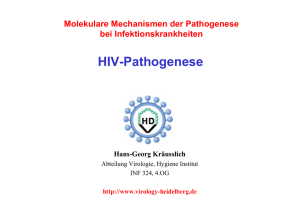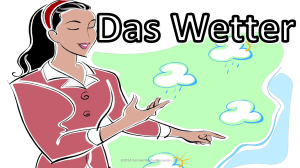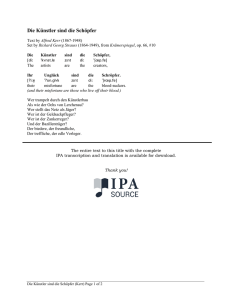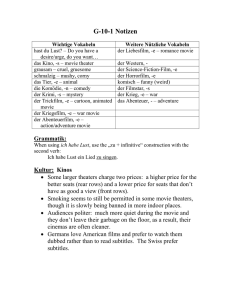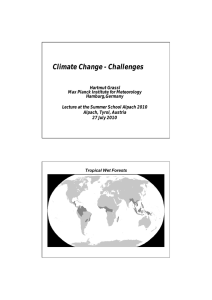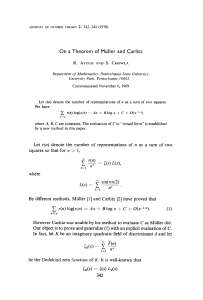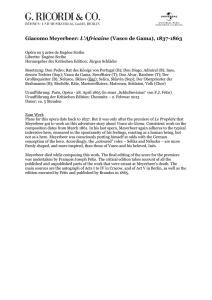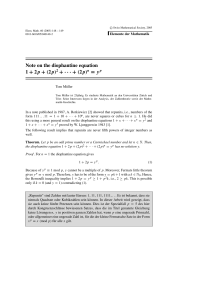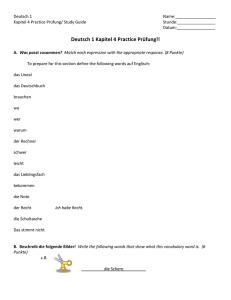HIV-Pathogenese
Werbung
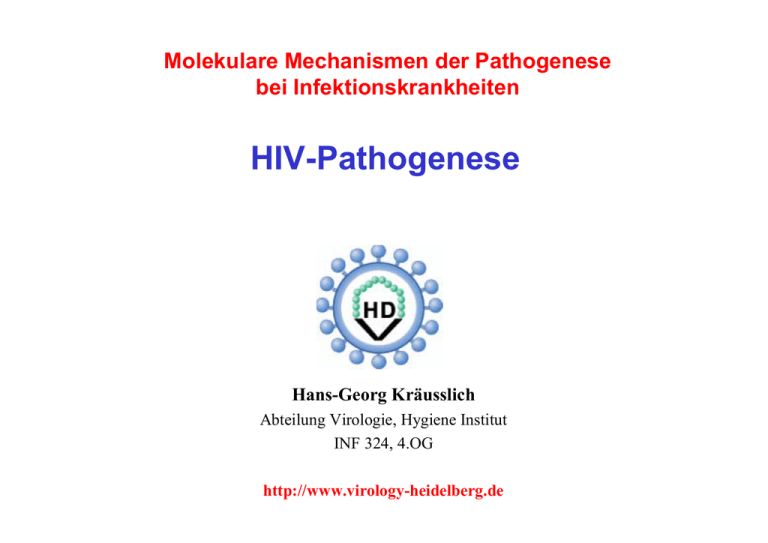
Molekulare Mechanismen der Pathogenese bei Infektionskrankheiten HIV-Pathogenese Hans-Georg Kräusslich Abteilung Virologie, Hygiene Institut INF 324, 4.OG http://www.virology-heidelberg.de Eine Pandemie der Gegenwart Entfernter Donner Morbidity and Mortality Weekly Report, 5.6.1981 Pneumocystis Pneumonia --- Los Angeles In the period October 1980-May 1981, 5 young men, all active homosexuals, were treated for biopsy-confirmed Pneumocystis carinii pneumonia at 3 different hospitals in Los Angeles, California. Two of the patients died. 15-39% All 5 patients had 5-15% laboratory-confirmed previous or current cytomegalovirus 1-5% Prävalenz in (CMV) infection and candidal mucosal0,5-1% infection. Case reports der 0,1-0,5% of these patients follow....... Bevölkerung <0,1% unbekannt Heute: 5 Millionen Infektionen pro Jahr 3 Millionen Tote pro Jahr Humanes Immundefizienzvirus Umhüllte RNA-Viren HIV-1 2 Typen (HIV-1, HIV-2) mit zahlreichen Subtypen Reverse Transkriptase im Virus RNA=>DNA Integration ins Wirtsgenom ss + Strang, ca. 9 000 Nukleotide Relativ instabil HIV is a monkey-derived virus HIV-1 and HIV-2 are caused by independent transmissions from chimpanzee and sooty mangabey, respectively. HIV-1 type O is derived from a related gorilla virus. Three independent monkey to human transmissions (from chimpanzees) caused epidemics with M-, N-, and Ogroup HIV-1. Zentrale Stellung der CD4+ T-Zellen für die erworbene Immunität HIV infiziert CD4-positive Zellen, die den Korezeptor CCR5 oder CXCR4 tragen Primary HIV-infection Unspezific symptoms 1 to 3 weeks after exposition similar to infectious mononucleosis ¾ p24-Antigen detectable by 4 weeks p.i. ¾ HIV-genome detectable by 4 weeks p.i. ¾ Seroconversion 3 to 12 weeks p.i. ¾ Strong reduction in virus load with immune response Maculopapillary exanthema in primary HIV-infection Course of HIV infection infection seroconversion minor or no symptoms disease markes Set point Prognosis!! ARC / AIDS virus load CD4+ PBL immune response antibodies to HIV env HIV-specific CTL antibodies to p24 4-8 weeks up to 12 years 2-3 years Die Wahrscheinlichkeit, AIDS innerhalb von drei Jahren zu entwickeln % CD4 -Zellen/µl >750 501-750 351-500 201-350 <200 100 80 60 40 20 0 >30K >55K 10K-30K 20K-55K 3K-10K 7K-20K 501-3K 1500-7K <500 VL bDNA <1500 VL PCR AIDS: Opportunistic infections CMV-Retinitis Kaposi-Sarkoma Cytomegalovirus Interstitial Pneumonia: Pneumocystis carinii Human Herpesvirus 8 Oral Leukoplakia Epstein-Barr-Virus Oral Candidiasis Candida albicans Der Verlauf der HIV-Infektion wird von Virusreplikation und Immunantwort bestimmt Rolle von Antikörpern in der HIV-Infektion Störungen der zellulären Immunantwort bei HIV-Infektion CD4+-Zellen: Zytolyse (virus- und CTL-induziert) Störung der Proliferation (IL-2; IL-2 Rezeptor) Verminderte Antigen-spezifische Antwort CD4-Oberflächenexpression lösliches HIV-env bindet an CD4 und blockiert sterisch CTLs: Reduktion der Zellzahl Fehlende CD4+ Helferzellen Spätphase der Infektion Infektion und Lyse der Vorläuferzellen Monozyten/MO: Nur zum kleinen Teil infiziert Gestörte Chemotaxis, Fc-Rezeptorfunktion, Komplement-vermittelte Elimination vermutlich durch lösliches, virales Antigen B-Zellen: Polyklonale Aktivierung (lösl. virales Antigen) Autoantikörper NK-Zellen: Geringe Zytotoxizität (fehlende Helferzellen; Zytotoxizität ist IL-2 abhängig) Der Eisberg Plasma (2% der Viruslast) Lymphatisches Gewebe (98% der Viruslast) Viruslast Viral reservoirs and plasma viremia Activated T cell 106 Resting Tcell (G1) Quiescent Tcell (Go) HAART Viral RNA (copies/ml) 105 Therapy can dramaticallymacrophage reduce virusDendritic load in cell almost all patients under therapy t1/2: 24h 104 Therapy can be sucessful for several years 103 Drug therapy cannot the virus from latently t1/2: eliminate 14d 2 10 infected cells harbouring integrated genomes t1/2: 8months Life-long therapy? 101 t1/2: years 0 6 12 24 T (months) Currently available therapeutic approaches against HIV Receptor binding Fusion Maturation ¾ RT inhibitors ¾ PR inhibitors Reverse Transcription Integration Transscription ¾ entry/fusion inhibitors Assembly Translation Budding Deaths per 100,000 Population Trends in Annual Death Rates Among Persons 25 - 44 Years Old, USA, 1982 - 2000 40 35 30 25 20 15 10 5 0 82 82 84 84 86 86 88 90 Year CDC 92 94 96 98 00 Dynamik der HIV-Infektion Flint et al., Molecular Virology, 2004 HAART restores CD4 counts and reduces the risk of AIDS CD4 virus HAART AIDS 500 200 0 0.5 8 0 0.5 years IMMUNE RESTORATION WITH HAART (or HAART plus IL-2) • Increased number of CD4+ lymphocytes • Increased number of naive T cells • Immune response to recall antigens • Increased proportion of cells specific for certain pathogens • Increased proportion of IL-2 producing CD4 T cells to anti CD3 mAb • Increased thymic outcome of T cells HIV-specific immunity not restored Therapeutic vaccination Principle: boost the specific antiviral immune response of patients in order to allow temporal or long-lasting control of virus replication in the absence of therapy Aims: ¾ allow patients to stop drug use for a given period of time ¾ enhance viral control under HAART to prevent treatment failure ¾ allow the delay of HAART onset, in particular if drugs are not available Optimistic aim: turn patients into long-term non-progressors Very optimistic aim: eradicate virus Therapeutic vaccination Post- HAART? Plasma virus HAART + vaccine Restore immunity to HIV anti-HIV CTLs + antibodies CD4 T cells anti-HIV CD4 T cells
